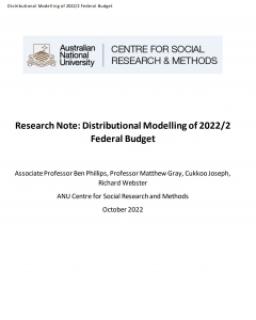
Abstract
The new Labor Government’s first budget (October 2022-23 Budget) includes a range of revenue and expenditure measures and updates the financial position of the Federal Government. This Research Note focusses on the distributional impact ofselected new measures relating to the personal income tax and social security system. The financial gains and losses accruing to households as a result of policy change through the first term of the Labor Government are reported. This analysis combines measures from both the previous and current governmentsin an attempt to understand the likely financial impact of policies delivered through the first three years of the 47th parliament.
The policy changes modelled are the:
- increase in Parental Leave Pay (PLP) from a maximum of 20 weeks to 26 weeks
- increase in child care subsidies
- the implementation of the stage 3 tax cuts which cuts passed parliament under the previous Coalition Government and which will be implemented in 2024-25 The analysis is based on the full impact of the increase in Parental Leave Pay, increase in child care subsidies and the stage 3 tax cut assuming their full implementation by 2024-25.
The modelling reported in this paper is for 2024-25. There are a number of other measures in the October 2022-23 Budget that will also have important impacts at the household level such as changes to Aged Care, the cost of medicines and funding for more public housing but such impacts are more complicated to assign at the household level and beyond the scope of this paper.
File attachments
| Attachment | Size |
|---|---|
| Budget_2022_2_Research_Note_FINAL.pdf(1.59 MB) | 1.59 MB |